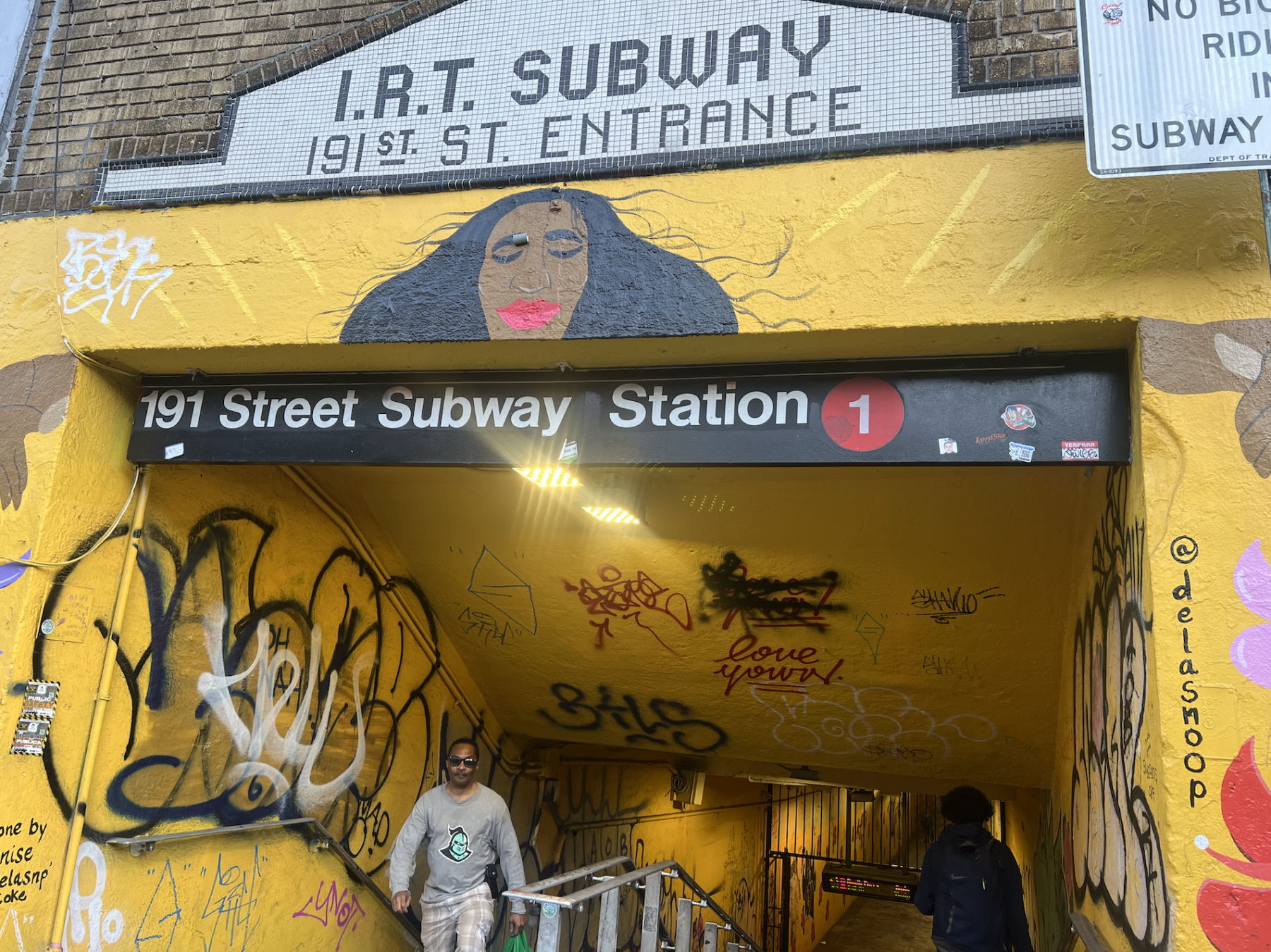
The 191st Street subway station in Washington Heights is a hotbed for crime. (Credit: Ayushee Roy)
A long tunnel glazed with vibrant graffiti snakes out from beyond the gantry at the 191st Street subway station in Washington Heights. As one of the deepest stations in the city, it is located more than 173 feet or nearly 70 stairs below street level. This station is also known among locals in the neighborhood for being a hotbed for crime. Marty Vergis, a retired Dominican resident who has lived in the area for more than 45 years, is no stranger to its reputation.
Sitting at Fort Tryon Park, a short walk from the station, Vergis recounted the story of a local man who was taking the train to see his girlfriend but never arrived, because he was stabbed by a stranger.
“You go somewhere alone and pray it will be okay.” Vergis said. “Sometimes there’s police on the train. But when it’s weekends, midnights, and there’s a lot of noise on the train there’s no police.”
Tyron Pope, a retired New York City Police Department sergeant who now teaches criminal justice at John Jay College, shared that this was no coincidence.
“These incidents are just not isolated acts of violence but a reflection of deeper systemic issues when it comes to addressing distributive injustices in terms of availability of socioeconomic resources in areas like Washington Heights and Inwood, where there may be fewer police on patrol and fewer areas under surveillance,” said Pope. “This emboldens offenders to evoke violence without risk of repercussion.”
In August, Edward Caban, the city’s first and only Latino police commissioner, resigned following a federal investigation into key city government officials. Two-thirds of the residents in Washington Heights, which is lovingly known as Little Dominican Republic, identify as Hispanic.
But at a time when total crime is increasing in the northern Manhattan region despite a dip in city-wide numbers, fears about subway safety are more prominent among Heights residents than concerns about Caban’s departure.
Argenis Betances, a young Dominican father living in the area, said that it didn’t matter if Caban was still in power or not, because his absence will not have a real impact on the neighborhood.
A 2020 Department of Justice study showed that the proportion of police officers identifying as Hispanic had increased by more than five percent, from the late 90s. Even so, general faith in law enforcement among Hispanics remains low.
“It’s plausible that there’s an ambivalence amongst the Latino community because descriptive representation does not necessarily translate into substantive representation,” said Marcel Roman, an assistant professor of government at Harvard University, where he specializes in racial and ethnic politics in the United States through the examination of the policing of the Latino community. “If someone’s in power that looks like the community but is not shifting those policies to actually alleviate the community, it makes sense that they don’t think their circumstances have changed in a substantive way.”
Vergis too, echoed this sentiment, saying that not much will change for Heights’ residents, and that when someone is caught up in a wrongdoing of Caban’s magnitude, they must pay for their actions – regardless of status.
What concerns both men more, however, is their first-hand experience of safety, on the subway.
The average commute time for Washington Heights residents exceeds 40 minutes, almost 25 percent higher than the city-wide average. This means that Heights’ residents may often need to travel beyond rush hour, risking exposure to vulnerable scenarios on the subway, alone.
Pricila Mendez, a half-Dominican social worker who recently moved to the neighborhood, avoids taking the subway altogether. When she has no other choice, she carries a taser for protection.
Between August and September alone, there have been four reported cases of stabbings along the subway in this district. The victims, all in their 30s, were attacked in the twilight hours with few witnesses around to intervene.
Pope also raised concerns that there might be a difference between reported and real crime in the neighborhood, since immigrants tend to be more skeptical of law enforcement. A 2018 survey by the Bureau of Justice Statistics, revealed Hispanics were the least likely of all racial groups to initiate contact with the police.
“It’s not in our culture to report much,” said Betances as he played with his daughter at the playground. “Back in our country, police don’t help much, so it’s in our genetics. We don’t bother reporting. We may see two people fighting but not call the police. Know we won’t get justice so why bother? It’s just not in us.”
After one of the recent reported stabbings, the victim allegedly did not cooperate with police and declined to describe his attacker.
Vergis said he thinks cops take too long to show up and stop crimes in progress. Christopher Herrmann, an expert from John Jay College, who studies crime trends in New York City, explained why this may be the case.
“Once a neighborhood gets safe, police move on to the next. It’s kind of a catch-22 sometimes: when the crime numbers go down, I live in a safe neighborhood but then there are fewer cops on patrol, and no one to report the crime to over there.” said Herrmann.
Caban’s untimely departure, marking the end of NYPD’s brief Hispanic lead, could have a ripple effect on future generations aspiring to enter law enforcement.
“I think, overall, it would negatively impact the next person who fits his demographic when they try to run” for election, said Mendez.
About the author(s)
Ayushee Roy is a part-time poet and full-time journalist, deeply passionate about creating diversity in thought and circumstance in the newsroom.



